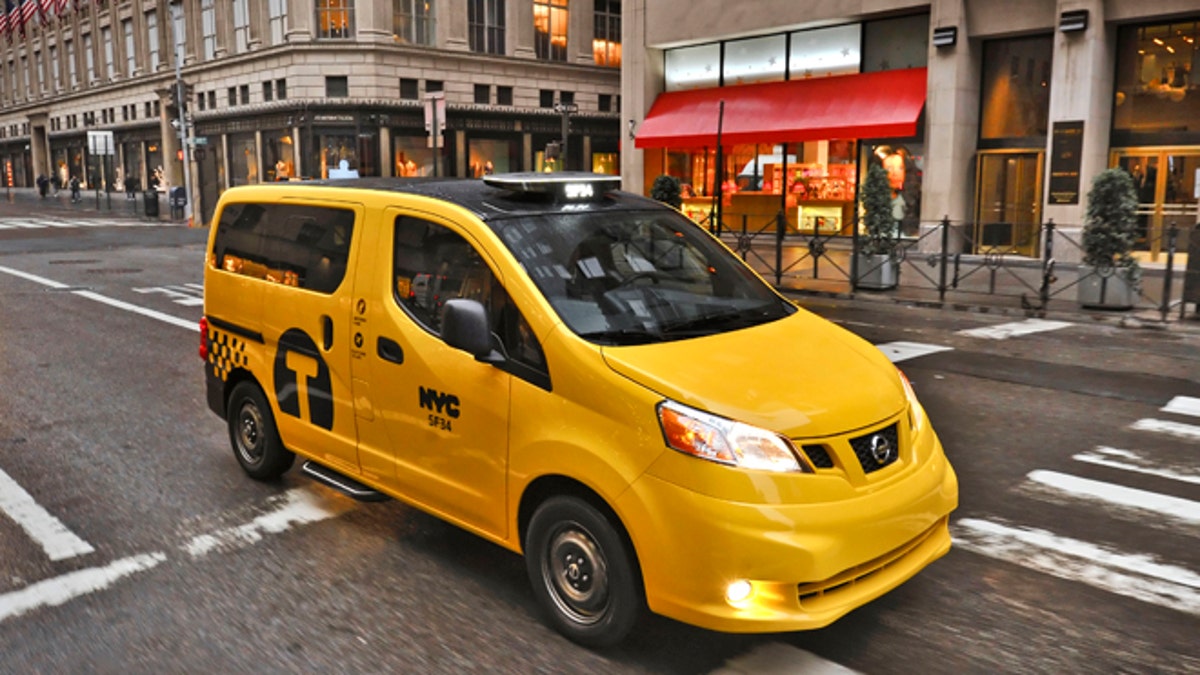
The Nissan NV200 utility van features a host of amenities, including increased legroom, sliding doors with entry steps, a large sunroof, independently-controlled rear air conditioning, an electrical outlet, two USB ports and a “no hump” floor for a more comfortable ride. (NissanNews.com) (Copyright 2012)
New York City’s iconic taxicab could become a thing of yesterday as the controversial “Taxi of Tomorrow” inches closer to reality — and the rugged streets of Gotham.
The Nissan NV200 utility van represents the city’s first wholesale redesign of its cab fleet since days of the Checker cab and features a host of amenities, including increased legroom, sliding doors with entry steps, a large sunroof, independently-controlled rear air conditioning, an electrical outlet, two USB ports and a “no hump” floor for a more comfortable ride.
Critics of the vehicles, however, say the van is neither accessible nor environmentally friendly, and has never been crash-tested with a partition installed. They also cite a decision last month by a New York State Supreme Court judge blocking Mayor Michael Bloomberg’s plan for a near-uniform fleet of 13,000-plus cabs, ruling that it violated a city provision requiring a hybrid option for taxi operators.
[pullquote]
“There’s nothing ‘Taxi of Tomorrow’ about it, it’s not a hybrid vehicle,” said Ethan Gerber, executive director of the Greater New York Taxi Association. “It’s a taxi of yesterday.”
The city’s Taxi & Limousine Commission will hold a public hearing and vote on Thursday to approve a comprehensive package of rules to “fully address” last month’s legal setback, according to spokesman Allan Fromberg. A number of civic and business leaders are expected to voice their support for the 4-cylinder, $29,700 van expected to hit city streets in October as its aging fleet is replaced.
“I’m expecting that the TLC commissioners will hear testimony on how the NV200 will be the safest taxi put on the road yet by far,” TLC Chairman David Yassky told FoxNews.com. “And it will deliver better service to taxi customers than any of the taxis now on the road.”
Although it has been analyzed during simulations, Fromberg acknowledged that the NV200 has yet to be physically crash-tested, but said it would be within the next couple of months and long before the vehicle reaches New York streets.
In September, TLC officials paved the way for the NV200 by approving regulations requiring the replacement of older cabs, officially making the Nissan van the city’s cab for a decade once an exclusive agreement begins later this year assuming it’s legal troubles are eventually ironed out.
But that’s far from a certainty, Gerber said.
Of the city’s 13,000 cabs, roughly 6,000 are hybrids that can get up to 50 miles per gallon. The NV200, as currently built with a combustion engine, will reportedly get about 24 miles per gallon under city driving conditions.
The lengthy contract is also problematic, according to Gerber, because it will restrict innovations in the next few years, including electric- or solar-powered vehicles. He’s also concerned how it will perform in physical crash-tests, despite assurances by TLC officials that it will exceed expectations.
“What we can’t understand is, if you’re going to select a uniform car, why not select one made in the United States and why give it a 10-year contract?” Gerber said. “This is a rush to put something on the road that hasn’t been tested or vetted.”
Gerber claims the rear-loading van is also a rough ride for disabled passengers, as he said only one person fits in the backseat with a wheelchair.
“So it’s a giant step backward on so many different levels,” he said. “It seems like a lot of things are being sacrificed for a little leg room. This is going to be a failure. It doesn’t make sense all around.”
Nissan officials have said the NV200’s wheelchair ramp will be 30 inches wide and 72 inches long with a ramp angle of 8.6 degrees, exceeding the Americans with Disabilities Act (ADA) regulations. It will also be able to support 800 pounds, or 200 pounds above the ADA minimum requirement.
Yassky, meanwhile, said the NV200 is twice as fuel efficient as the ubiquitous Ford Crown Victoria, which also is manufactured outside of the United States. A hybrid version of the vehicle will be available within two years and as a fully-electric model later in the program, he said.
“I think it’s true that every innovation that the Bloomberg administration has set forth met resistance from at least parts of the industry,” Yassky said when asked why the vehicle is so controversial.
Whatever fate awaits the NV200, it’s clear millions will be impacted by the decision pertaining to one of the city’s main modes of transportation.
In December, Bloomberg announced that New York City welcomed a record 52 million visitors — including 11 million from overseas — in 2012, an all-time high and 2 percent increase from 2011. Those visitors generated an estimated $55.3 billion in economic impact, with direct spending nearing $37 billion.
“New York City continues to attract people from all around the world who want to experience our unique culture, food, parks, shopping, arts and energy,” Bloomberg said. “The tourism industry is thriving, creating thousands of jobs for New Yorkers at all rungs of the economic ladder. We are well on our way to achieving our new goal of 55 million visitors and $70 billion in economic impact by 2015.”

